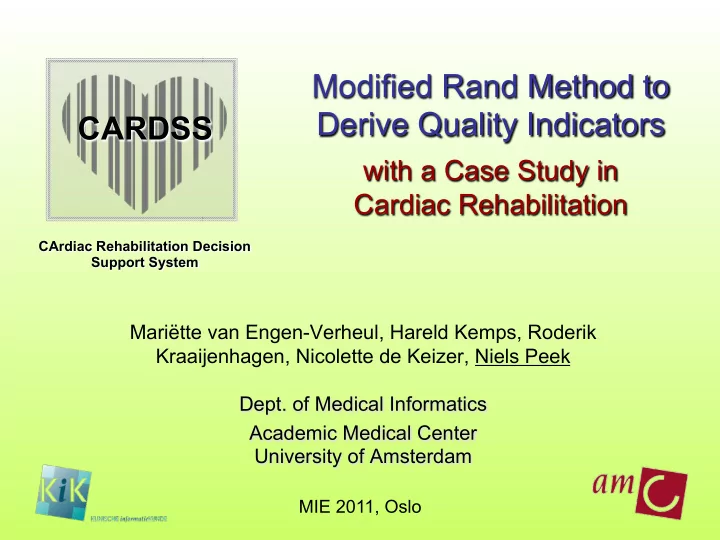

Modified Rand Method to Derive Quality Indicators CARDSS with a Case Study in Cardiac Rehabilitation CArdiac Rehabilitation Decision Support System Mariëtte van Engen-Verheul, Hareld Kemps, Roderik Kraaijenhagen, Nicolette de Keizer, Niels Peek Dept. of Medical Informatics Academic Medical Center University of Amsterdam MIE 2011, Oslo
guideline implementation systems
the CARDSS project CARDSS • guideline implementation in cardiac aftercare • CDS system based on Dutch cardiac CArdiac Rehabilitation Decision rehabilitation guidelines Support System • was used in ± 40 clinics in the Netherlands
conclusions from CARDSS RCT • system was shown to improve professional adherence to the guidelines (Goud et al., BMJ 2009;338:b1440) – “checklist” effect – no need to memorize guidelines – better shared decision making • … but there were no changes at the organisational level – lack of personnel or facilities – poor collaboration with other departments
CARDSS CARDSS-II Audit & Feedback loop Knowledge quality indicators revision loop data registry
the RAND method (Brook et al., 1986) Literature search Criticisms • lack of patient involvement Preliminary QIs • clinical practice guidelines are not consulted Rating procedure (expert panel) • unclear definition of appropriate care Consensus meeting (expert panel) • weak reliability of the rating and consensus procedures Final set of QIs
our modifications (1) Literature search Preliminary QIs Rating procedure (expert panel) Consensus meeting (expert panel) Final set of QIs
Both professionals our modifications (1) and patients Expert panel Literature search Preliminary QIs Rating procedure (expert panel) Consensus meeting (expert panel) Final set of QIs
our modifications (2) Review of guidelines Expert panel Literature search Preliminary QIs Preferred structures and procedures Rating procedure (expert panel) Consensus meeting (expert panel) Final set of QIs
our modifications (3) Review of guidelines Expert panel Literature search Preliminary QIs 5-point Likert scale ratings for Rating procedure 1) relationship with (expert panel) patient outcomes 2) possibilities for improvement Consensus meeting 3) ease of recording (expert panel) Final set of QIs
our modifications (4) Review of guidelines Expert panel Literature search Preliminary QIs Rating procedure (expert panel) Nominal Group Consensus meeting Technique (expert panel) (Dunham, 1998) Final set of QIs
application in cardiac rehabilitation Expert panel • 38 professionals (40 invited) • 15 patients (30 invited) • 92 quality characteristics
application in cardiac rehabilitation Expert panel Literature search • 314 relevent articles • 15 quality indicators • 24 outcomes measures
application in cardiac rehabilitation Review of guidelines Expert panel Literature search • Dutch Guidelines for Cardiac Rehabilitation • 34 procedural requirements • 3 structural requirements
application in cardiac rehabilitation Review of guidelines Expert panel Literature search Preliminary QIs • 81 potential QIs for cardiac rehabilitation
application in cardiac rehabilitation Review of guidelines Expert panel Literature search Preliminary QIs We were unable to Rating procedure include patients in ( professionals ) this part of the procedure • 60 rated QIs for cardiac rehabilitation
application in cardiac rehabilitation Review of guidelines Expert panel Literature search Preliminary QIs Rating procedure (professionals) Consensus meeting (professionals) Final set of QIs • 18 QIs for cardiac rehabilitation
some examples Structure • The rehab teams uses a shared, multidisciplinary (and preferrably electronic) patient record Processes • Fraction of patients for which an individual care plan is established at the onset of rehabilitation Outcomes • Each patient ’ s improvement in exercise capacity, measured before and after rehab by bicycle ergometry
discussion • the 4 different QI sources were (partially) complementary to each other – each source provided candidate QIs that were not provided by the others • professionals rarely mentioned outcomes of care • it was easy to reach consensus during the meeting – probably due to the well-structured rating procedure • it was not easy to involve patients • we did not involve other stakeholders (e.g. insurance companies)
current & future work • CARDSS Online – web-based quality feedback application – achievable benchmark methodology (Kiefe et al., 2001) – quality improvement plan • evaluation study – cluster RCT – factorial design (decision support / feedback) – ± 20 cardiac rehab clinics
conclusion • different sources of information should be consulted when defining indicators of care quality • there should be clarity (and agreement) about the definition of quality to achieve consensus Contact : Niels Peek CARDSS Dept. of Medical Informatics Academic Medical Center University of Amsterdam n.b.peek@amc.uva.nl
Recommend
More recommend